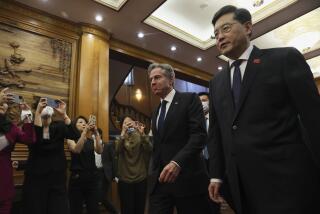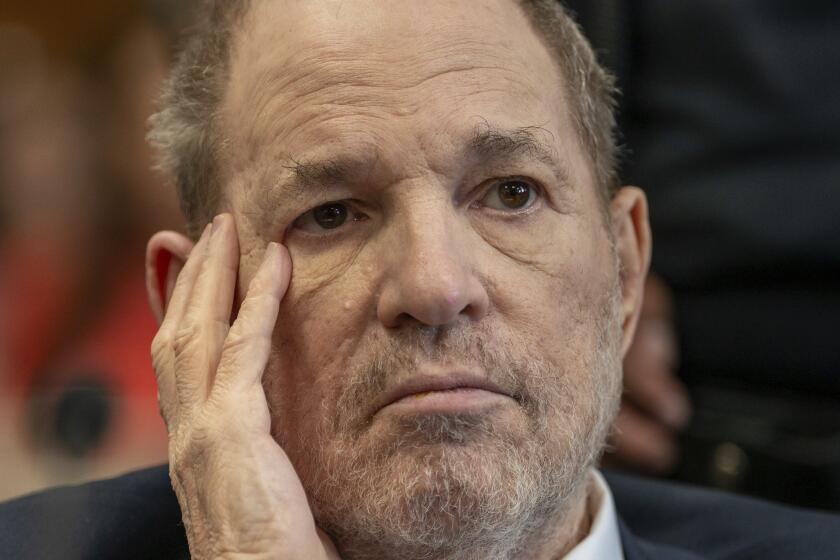Why Hold Hundreds Without Charges -- in Cuba?
There are 450 men from more than three dozen countries detained as “enemy combatants” in a seaside network of seven -- soon to be eight -- camps and prisons at the U.S. Naval Base in Guantanamo Bay, Cuba. Following are some frequently asked questions.
Question: Why does the United States have a base in Cuba?
Answer: The oldest U.S. base overseas and the only one in a communist country, the naval station is positioned at a strategic point between the Atlantic Ocean and the Panama Canal. It has been expanded and modified since the U.S. government leased 45 square miles of land and water from the newly liberated island nation in December 1903. A 1934 treaty set the annual rent at $2,000 in gold, or $4,085 today, and deemed the lease permanent unless both parties agreed to any changes. Communist revolutionary President Fidel Castro has wanted to break the lease since he took power in 1959 and has refused to cash any of the checks.
Q: What crimes are the prisoners at Guantanamo accused of?
A: Only 10 of the men have been charged with war crimes, for their alleged roles in aiding Taliban and Al Qaeda operatives responsible for the Sept. 11, 2001, terror attacks, and assaults on U.S. forces who invaded Afghanistan a month later. The other 440 were captured by Afghan, Pakistani, U.S. and other authorities and accused of engaging in combat or plotting to do harm to Americans and their allies.
Q: Why does the government continue to hold men who haven’t been charged with a crime?
A: The Bush administration claims the right, under the laws of war, to indefinitely detain “enemy combatants” while the nation is at war -- in this case, the global war on terrorism. Detention prevents prisoners from returning to the battlefield and endangering U.S. forces or U.S. national security, the administration argues. Under the Geneva Convention, captured enemy forces may be held as prisoners of war but must be provided specific rights and protections. For instance, POWs are housed in quarters equivalent to those for U.S. forces, are allowed to keep their personal effects, can work and receive compensation, and are not subject to interrogation. The Guantanamo detainees are not accorded these rights.
Q: Why was Guantanamo chosen as the site for the United States’ captured enemies in the war on terrorism?
A: Initially, officials at the White House and the Pentagon believed they were under no obligation to accord U.S. constitutional rights and protections to noncitizen detainees held outside U.S. soil. However, two years ago, the Supreme Court ruled on a prisoner’s challenge, Rasul et al. vs. Bush, that anyone in U.S. custody anywhere has the right to challenge his captivity in federal court. That ruling was just on the right to challenge detention, but opened the door to Hamdan vs. Rumsfeld.
Q: Why was the Supreme Court looking at the military tribunals?
A: After the Rasul ruling, attorneys for Yemeni Salim Ahmed Hamdan appealed to U.S. district court with a challenge to the legality of the military commissions set up to try those accused of war crimes. Hamdan’s challenge resulted in Thursday’s Supreme Court ruling that President Bush exceeded his war powers when he created the tribunal.
Q: How are the Guantanamo detainees affected by the Supreme Court ruling?
A: Only the 10 charged detainees are directly affected by the decision, and the consequences won’t be immediate even for them. The president may seek congressional authorization for another kind of offshore military court, or the administration may try those charged with war crimes in U.S. federal courts.
Q: What about the other 440 men -- will they also receive trials?
A: Military prosecutors have said for months that charges were pending for at least two dozen more prisoners, and the number prosecuted could reach 75. But with international pressure mounting against the Guantanamo operations and the government likely to have a tougher time securing convictions in U.S. courts, the State Department is negotiating with detainees’ home countries in an effort to transfer custody and responsibility for the men.
Q: If the Bush administration is trying to downsize Guantanamo, why is it building new detention facilities?
A: The $30 million in funding for the medium-security, 100-cell Camp 6 due to open in August was budgeted more than two years ago. Military officers running the detention operations also note that the first three camps constructed at Guantanamo in early 2002 -- the metal mesh cells arrayed in open-air rows in Camps 1, 2 and 3 -- are rusting and nearing the end of their five-year intended life span. Camp 4, a barracks-like communal-living facility for as many as 200 detainees with the best behavior records, is mostly empty now because of repairs underway after a May 18 uprising.
Q: How can a prisoner get released from Guantanamo?
A: Of the 759 men known to have been brought to the detention network since January 2002, about 300 have left the island after being judged by panels of military officers as “no longer an enemy combatant” or when their home governments agreed to take responsibility for them. Three committed suicide. About 100 still at the prison have been judged eligible for transfer or release by annual Administrative Review Board hearings. Another round of the assessments is underway to reconsider the need to hold the 330 or so deemed last year to require continued detention because they posed a threat to U.S. security if released or because they could provide intelligence under interrogation.
More to Read
Start your day right
Sign up for Essential California for news, features and recommendations from the L.A. Times and beyond in your inbox six days a week.
You may occasionally receive promotional content from the Los Angeles Times.







